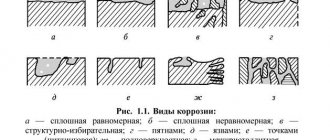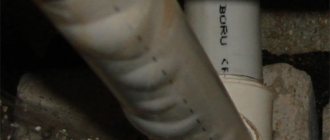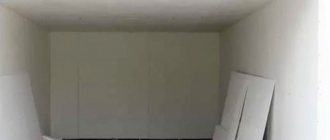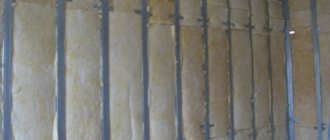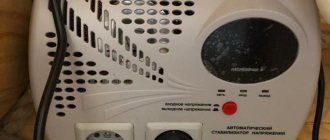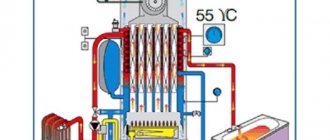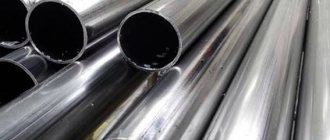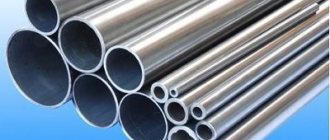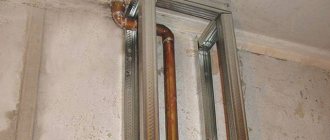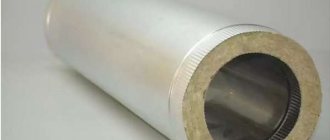Many people, having installed a new stainless steel water heated towel rail in the bathroom, after some time notice that small spots of rust have appeared on the surface of the metal, the diameter of which usually does not exceed 5-6 mm. This “scattering” is nothing more than banal metal corrosion. And the point here is not at all about a defective plumbing product or improper operation, but about stray currents. What is this? Where do they come from? And how to neutralize their harmful effects on the heated towel rail? Let's understand the issue.
What do you need to know about stray currents?
Any metal objects located in water or in the ground, regardless of their purpose, are susceptible to corrosion, which can be:
Galvanic
It involves the reaction between different metals. For example, a galvanic couple leading to destruction can be created by steel and brass or steel and aluminum. The reaction begins as soon as a “duet” of different metals is formed and the resulting assembly comes into contact with the electrolyte. In the situation with a heated towel rail, the role of electrolyte is played by ordinary tap water, which reacts with metals due to the content of a significant amount of minerals (the same reaction will occur with sea water rich in salt). And the higher the water temperature, the more active the process of metal destruction occurs. That is why the hulls of ships that sail in the warm southern seas wear out faster than ships in the northern fleet.
Corrosion of stray currents
This process is caused by so-called stray currents that arise in the ground if it functions as a conductive medium. In this case, not only metal objects that are completely in the ground are exposed to destructive effects, but also those that are only in contact with it. But where do these currents come from? It's simple: in most cases, their appearance is the result of leakage from power lines. This group also includes the so-called zero currents present in ungrounded structures.
First signs of corrosion
You can determine that your heated towel rail has become a “victim” of corrosion processes by the appearance of the equipment. The first signs of metal destruction are:
- swelling of the decorative layer (paint) - first this occurs at joints and on sharp edges of the structure;
- the appearance on the affected surface of a noticeable whitish coating, reminiscent of fine powder;
- the formation of small dents and depressions in the damaged areas - it seems that the metal has been eaten by a bug.
Minor damage is usually the result of galvanic corrosion caused by the difference in electrical potential of dissimilar metals, one of which acts as a cathode and the other as an anode. And if you add stray currents to this, the destruction will be much more serious.
How heated towel rails rust - stages of electrocorrosion
On heated towel rails treated with paint, the decorative coating first begins to swell. On modern stainless steel dryers, corrosion spots with a diameter of 5-6 mm are visible.
Stages of development of electrocorrosion:
- First signs of rust. Small islands of corrosion appear on the surface of the pipe. The spots are usually small in size - about the size of a match head.
- The damaged area expands. Groups of stains come together, which increases the rate at which corrosion spreads.
- Damage to deep layers. When cleaning the pipe, you can notice that the metal is destroyed to a considerable depth. A funnel forms under the oxide layer.
- Pipe destruction. In most cases, the result of electrocorrosion is the destruction of the thread of the heated towel rail. However, a hole may appear on a flat surface.
The cause of electrocorrosion does not always lie in one’s own actions. The neighbor may be the culprit. For example, if during the repair he installed a dryer from a metal-plastic pipe or made an adapter from a riser to a plastic coil.
Electrocorrosion is possible in cases where a pipe exposed to current comes into contact with water. So-called breakdowns occur. When two metals with different chemical reactivity come into contact, a chemical process inevitably begins. Since the metal surface consists of many closed microelectrodes. Under the influence of electricity and mineral compounds contained in water, the structure is destroyed.
A little about the nature of stray currents and their danger
The reason for the appearance of stray currents acting on your heated towel rail is the difference in potential of grounded structures. And in order to equalize the potentials, it is necessary to create a system in which all metal elements will be in contact with the neutral conductor in the existing input distribution device.
Such a system will ensure maximum safety for the user (if you put your hand on a pipe and grounded equipment, you will not receive a fatal discharge). And this is very important, because the greater the potential difference, the more serious the danger threatens a person. For example:
- If this value is 4 or 6B, you may receive a 5 mA shock. It will be sensitive but not fatal.
- If its strength is 50 mA, cardiac fibrillation may develop.
- And when a human body is exposed to a current of 100 mA, death occurs.
But there are cases where even a small potential difference of 4B became the cause of death.
Potential difference: causes of occurrence
But where does the potential difference come from if the house is built taking into account all current standards? In theory, if building rules are observed, there should be no potential difference. But in practice, it often happens that when assembling structures and engineering systems, welded joints are replaced with bends. Another common option is to integrate additional resistances or metal parts into the circuit. Both can cause a potential difference to occur at opposite ends of the pipe and, accordingly, initiate metal corrosion.
We should not forget about the “conflict” between metal and plastic, which also plays an important role in the destruction of various peripheral devices (including heated towel rails). Due to the fact that plastic pipes are often placed between stainless steel plumbing equipment and a metal riser (they are used for wiring throughout the apartment), the connection between these parts of the system is broken. And although the riser will be grounded in any case (in new high-rise buildings this is done through an equalization system, and in older buildings - through a grounding loop located in the basement of the building), a potential difference will still form. And when water moves through pipes, which demonstrates excellent conductivity, microfriction also arises, which is guaranteed to lead to the appearance of stray currents. And they, in turn, provoke corrosion. The circle is closed!
Explanation in simple human language
The problem with corrosion of faucets and heated towel rails is that you have plastic pipes going to them, but the riser in the house is made of metal pipes. Metal pipes are all grounded, in new houses through a potential equalization system, in old houses - in the basement to the ground loop. When using plastic pipes, you break the metal connection between the riser pipes and the metal mixer or heated towel rail. Therefore, you break the potential, on the riser you have one - ground, on the heated towel rail - another. It's called potential difference. What appears between different potentials? Current - provided that a conductor appears between them, and such a conductor is the water flowing through the pipes. When water moves through pipes, micro-friction of various media occurs - water and metal, and what happens during friction? Remember the ebonite stick? That's right - tension, i.e. potential, the one in the riser is equal to the potential of the earth (grounded), and the one in the heated towel rail hangs on it by itself, and through the water between different potentials, stray currents arise, and as a result, corrosion. Water definitely has excellent electrical conductivity.
In our experience, Mario heated towel rails resist stray currents best; for this occasion, we are giving a 10% discount on any water model. When placing your order, simply enter promo code mario10 and receive a 10% discount.
ALL YOU NEED TO DO is to ensure a reliable metal connection between the riser pipes and the metal terminal devices (mixer, heated towel rail). Simply put, ground your heated towel rail to the metal pipes of the riser, the potential will equalize and the current will have nowhere to flow.
Why haven’t similar difficulties arisen before?
Strange as it may sound, progress has become the reason for the emergence of such a problem as potential difference in engineering systems. Namely, the widespread replacement of metal pipes with plastic ones. As long as the hot water supply, hot water supply and heating pipelines were completely metal, no difficulties arose. And there was no need to separately ground each radiator, faucet or heated towel rail either - all pipes were grounded centrally in the basement of the house, in two places. And all metal appliances in bathrooms and toilets automatically became safe and protected from stray currents.
The transition to plastic changed everything: on the one hand, pipelines began to last longer, and on the other hand, there was a need for additional protection of plumbing equipment. And here it’s not only about the pipes themselves, because in terms of conductivity, metal-plastic is close to traditional metal, but also about the fittings - connecting elements. More precisely, in the materials from which they are made and which cannot provide electrical contact with the aluminum “core” of the metal-plastic pipe.
Grounding as protection against electrocorrosion
To prevent the occurrence of stray currents in the system and protect the heated towel rail from electrochemical corrosion, it is necessary to recreate a stable connection between it and the riser pipe. In other words, you just need to ground the peripheral device by connecting the heated towel rail with a wire to a metal riser, or install a potential equalization system.
It is also important to do this because some unscrupulous residents of apartment buildings, wanting to save money, put bugs on their electricity meters and use pipelines from heating or water supply systems as grounding. And then their neighbors are in real danger, because even simply touching a metal battery will give a person a “chance” of receiving a fatal electric shock.
Are all heated towel rails the same?
There are various manufacturers of heated towel rails in Belarus and it is impossible to say unequivocally that the sales leader is any particular brand. Buyers are more likely to focus on design, cost, and only then pay attention to the manufacturer of the product.
The only thing that can be noted is that among the models presented on the market there are 2 manufacturers who have taken maximum care of the protection against electrochemical corrosion of the heated towel rail - these are “Sunerzha” (Russia) and “Gloss&Reiter” (Belarus). The Russian manufacturer uses an additional coating inside the heated towel rail, which increases the service life of the product, but does not provide a 100% guarantee. Products from the Belarusian manufacturer are much cheaper, and the protection in them is fundamentally different: they have tread protection, which also tends to wear out and will require replacement over time, but still, as the manufacturer claims, the service life of such a heated towel rail is much longer.
Polymer processing - a solution to the problem without grounding
But you can solve the problem in another way by treating the inner surface of a stainless steel water heated towel rail with a special polymer composition. It will create an insulating coating that will “work” effectively, preventing the formation of potential differences and the occurrence of corrosion.
Polymer treatment of water heated towel rails is an additional service that is performed by our company at the buyer’s request. And you can order it online on the ZIGZAG website.
Go to
Grounding schemes for polymer risers.
By default, an electric heated towel rail assumes that this device will be connected to a grounded outlet.
To ground a stainless steel water heated towel rail, the sequence of actions is as follows:
- We connect with a copper conductor with a cross-section of at least 2.5 sq. mm.
- We make a grounding jumper: we connect the conductor and the wire on the distribution panel.
- We secure the grounding wire to the heated towel rail pipe with a special clamp.
Simply put, you need to ground the heated towel rail to the metal riser pipes or ground loop.
